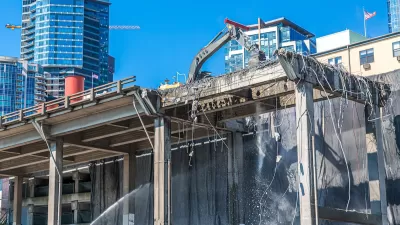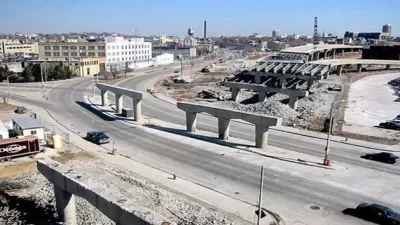In Michigan, the state's Department of Transportation is looking for ways to mitigate the damage caused by decades of urban renewal policies and reconnect neighborhoods cut off from amenities and opportunities by highway projects.

In response to criticism of the Biden administration's commitment to addressing the racism and discrimination built into U.S. roads, Nancy Derringer explains how roads and infrastructure can have disproportionately negative impacts on Black and brown communities, quoting Paul Ajegba, director of the Michigan Department of Transportation, who participated in a recent virtual panel on the issue. As Derringer writes,
Southeast Michigan is dotted with examples of roads and infrastructure that had the effect of dividing or demolishing neighborhoods populated by people of color. I-375, the spur that carries motorists from I-75 into downtown, is only the most obvious example. Built from 1959-65, it sliced through the footprint of the Black Bottom neighborhood, which had already been razed in the name of urban renewal. The generational wealth that was lost is incalculable, Ajegba said.
"Rather than top-down planning and development, today’s infrastructure design is more likely to be a collaborative effort that looks at nearby neighborhoods holistically, said Jon Kramer, another panelist and president of OHM Advisors, consultants who aid in such planning."
Planners are also recognizing the importance of multimodal transportation options and the need to replace car-centric infrastructure with safe, convenient facilities that benefit pedestrians, cyclists, and transit riders as well. Ajegba states that policymakers in Michigan have "a renewed emphasis on equity, inclusion and social justice."
FULL STORY: How can a road be racist? Don't ask that question in Michigan.

Alabama: Trump Terminates Settlements for Black Communities Harmed By Raw Sewage
Trump deemed the landmark civil rights agreement “illegal DEI and environmental justice policy.”

Study: Maui’s Plan to Convert Vacation Rentals to Long-Term Housing Could Cause Nearly $1 Billion Economic Loss
The plan would reduce visitor accommodation by 25% resulting in 1,900 jobs lost.

Why Should We Subsidize Public Transportation?
Many public transit agencies face financial stress due to rising costs, declining fare revenue, and declining subsidies. Transit advocates must provide a strong business case for increasing public transit funding.

Paris Bike Boom Leads to Steep Drop in Air Pollution
The French city’s air quality has improved dramatically in the past 20 years, coinciding with a growth in cycling.

Why Housing Costs More to Build in California Than in Texas
Hard costs like labor and materials combined with ‘soft’ costs such as permitting make building in the San Francisco Bay Area almost three times as costly as in Texas cities.

San Diego County Sees a Rise in Urban Coyotes
San Diego County experiences a rise in urban coyotes, as sightings become prevalent throughout its urban neighbourhoods and surrounding areas.
Urban Design for Planners 1: Software Tools
This six-course series explores essential urban design concepts using open source software and equips planners with the tools they need to participate fully in the urban design process.
Planning for Universal Design
Learn the tools for implementing Universal Design in planning regulations.
Smith Gee Studio
Alamo Area Metropolitan Planning Organization
City of Santa Clarita
Institute for Housing and Urban Development Studies (IHS)
City of Grandview
Harvard GSD Executive Education
Toledo-Lucas County Plan Commissions
Salt Lake City
NYU Wagner Graduate School of Public Service





























